Big Decisions, Big Races, and a Big Year All Around!
January 12th, 2022
2021 was an incredible year for me. I had my own ups, downs, and stressful times, but I recognize how truly lucky I am to be able to work and live in relative normalcy.
I trained and raced in my first half Iron Man and my third marathon. I skied a ton. I launched features for YouTube reaching millions of students around the world. And in the defining moment of my year (and possibly decade), I choose to quit my job at Google and work on OnePager full time.
I’m writing this mostly in self reflection, but if you choose to go further I hope you enjoy! (Note, there is a heavy emphasis on OnePager as this post goes on.)
Great People
2021 was first and foremost a year about spending time with the people I love. I started the year living in Lake Tahoe with my girlfriend Tori and a great group of 10 other friends. Afterwards, I spent time living with my parents and brother in Virginia. In April, I moved back into NYC with my longtime friend AJ and got to spend more time with dozens of friends in the city. I trained and ran a triathlon with 3 of my closest friends AJ, Chris, and Johnny. Then I left Google to work full time on OnePager with Nic and Adam, more great friends. Through all of these experiences I’ve gotten to spend time with my favorite people and meet new ones along the way—notably all of the great new founders I’ve met while building OnePager.
I also got to experience my first batch of friends' weddings: congrats to the year of the Griffins, the Hardejs, and the O’Connors! All incredible experiences, awesome groups of people, and I’m excited for more in 2022.
Three more highlights (out of many more I won't list): #1 a week with Tori living on Alistair and George’s houseboat in Sausalito. #2 a four day camping trip I took with 5 friends in Zion national park. #3 Memorial day weekend, where I convinced a big group to head up to Massachusetts for a great weekend... in the pouring rain.
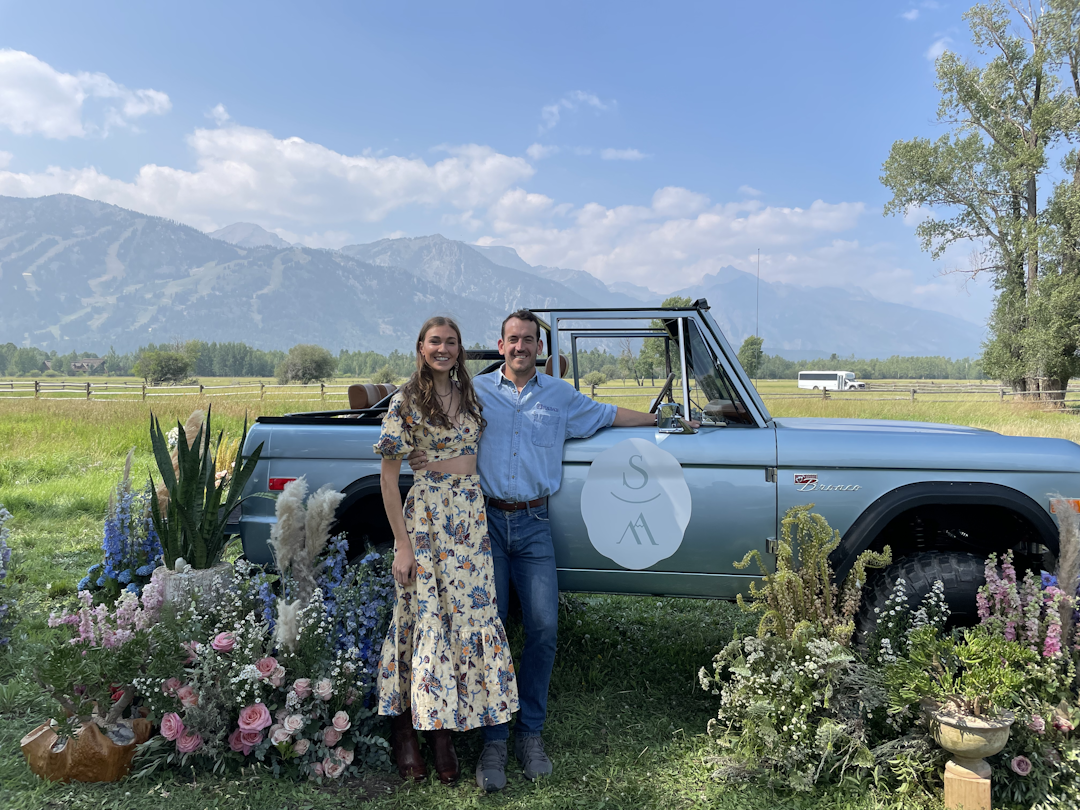
Tori and I at the Griffins wedding in Jackson Hole, Wyoming.
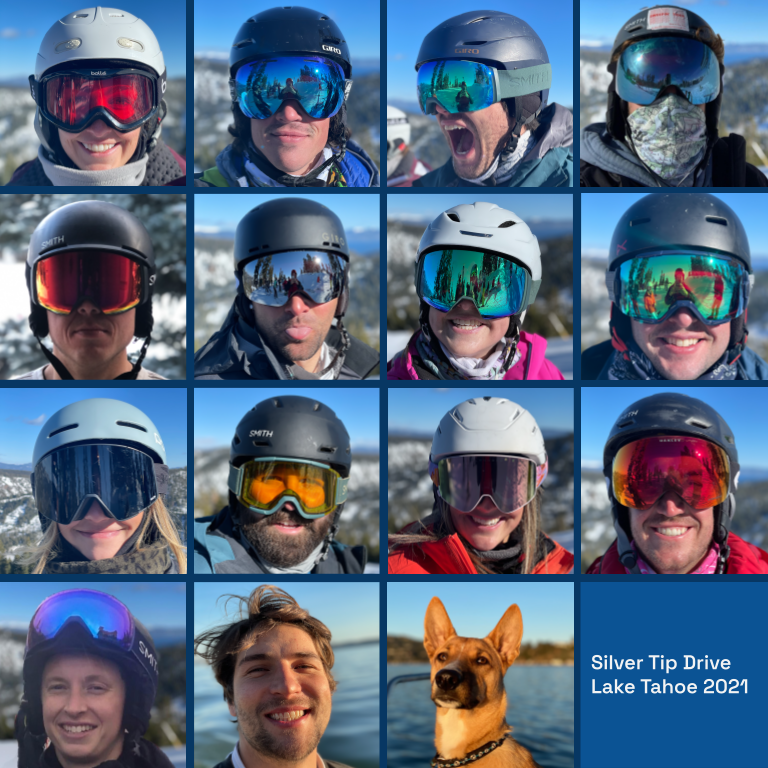
The main characters from our 2 month stay in Lake Tahoe.
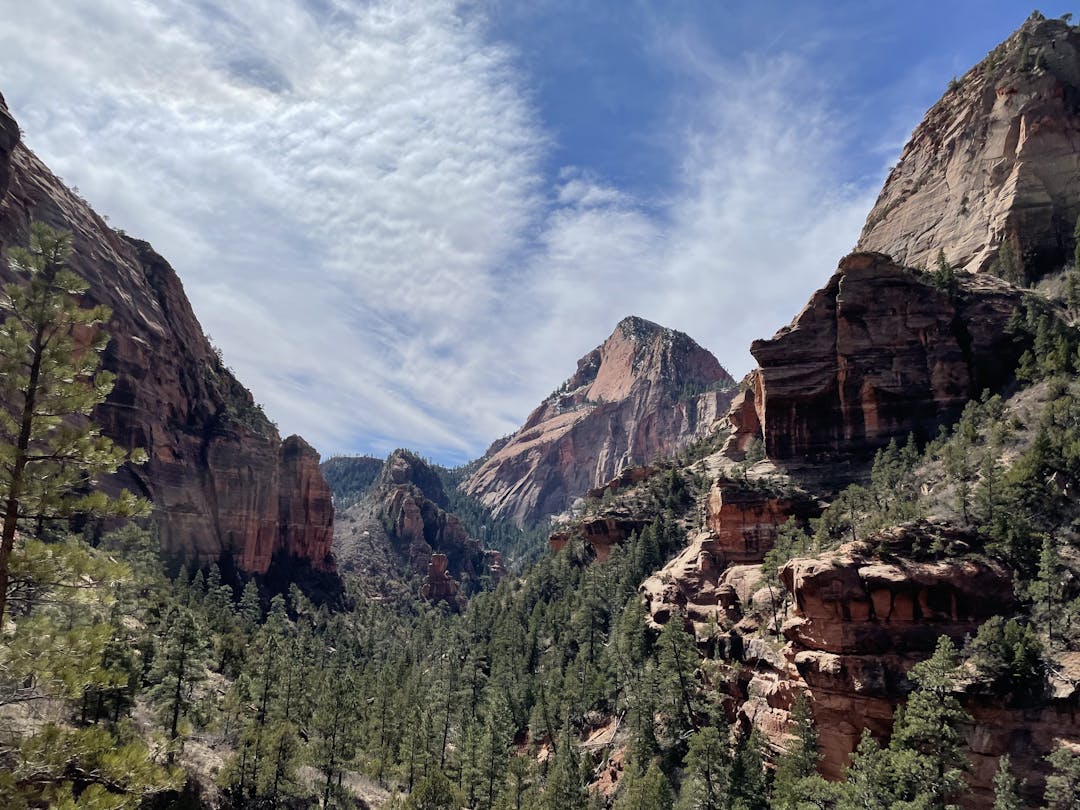
Kolob Canyon in Zion, shot during our 4 day camping trip across the park.
Big Mountains and Big Races
I started the year in Lake Tahoe trying to ski as much as possible. Half of our group of 12 was operating on East Coast hours, so we’d start working before sunrise and sneak in runs at the end of the day. I’d never skied more than a few days in a year before, but over the course of those 2 months I got on the mountain 36 separate days. I loved it, but eventually Tori and I missed NYC and it was time to reenter the real world.
After Tahoe, I spent a large chunk of my time training for my first half Iron Man triathlon - a 1.2 mile swim, 56 mile bike, and 13.1 mile run. Luckily I was a solid runner already, and I really enjoyed learning to swim long distance. Biking I’m still fairly indifferent about. Training for March, April, and May amounted to roughly 9 activities per week, usually swimming paired with running or biking. I was also lucky to be training for the race with three good friends (as I mentioned above), one of which was my roommate AJ.
The triathlon was on June 6th in Roanoke, Virginia, and happened to land on the 77th anniversary of D-Day and allied invasion of Normandy. Before the race, the congressman for the district gave a speech about the significance of our event happening in Roanoke on this day. With the sun rising over a reservoir in the Blue Ridge Mountains behind him, he explained that the “Bedford Boys,” kids from nearby Bedford county, were the tip of the spear on D-Day and suffered more causalities per capita than any other unit from the US. We could enjoy this race because of their sacrifice. Needless to say I was fired up to jump in the water and get started, it was a great moment that stuck with me.
The swim went well, and I did the bike faster than I expected. Unfortunately, the run was a disaster. After a cool morning it was 90 degrees by the time I started runing, and I’d overexerted myself on the bike. By mile 3 I started cramping in my legs. By mile 7 crippling cramps forced me to run-walk the last 6 miles. I ran through the finish strong, but ask me in person for the hilarious finish line details 🤖.
A month after recovering from the triathlon, Aj and I decided to run our third (and possibly final) New York City Marathon together. We’d run in 2018 and 2019, but 2020 had been canceled due to COVID. The 2021 race was set to be the 50th NYC marathon, and it seemed like too good an opportunity to miss out on. So, we trained, ran, and fundraised for the Leukemia & Lymphoma Society (LLS) under our team name Grooving Against Leukemia one more time.
Over the course of the summer and fall we raised $26,011 for LLS, and on race day we both smashed our marathon personal records (PRs). Compared to previous years, I think we’d started training earlier and been much more more deliberate about our nutrition. I’d finished both 2018 and 2019 races in a cramping run-walk (just like the 2021 Iron Man), but this this time I figured it out, crossed the finish line in a sprint, and ran a PR of 3:52, 15 minutes faster than my next best in 2019. I consumed a disgusting amount of salt during the run and my headphones died about 2 hours in, but it flew by and I honestly loved every minute!
Running these races has been an incredible experience for me physically and mentally, but above all it's been a great way for me to give back to LLS. Over the course of three we’ve raised $96,458!
For now we’ve decided this is the end of GAL... for now.
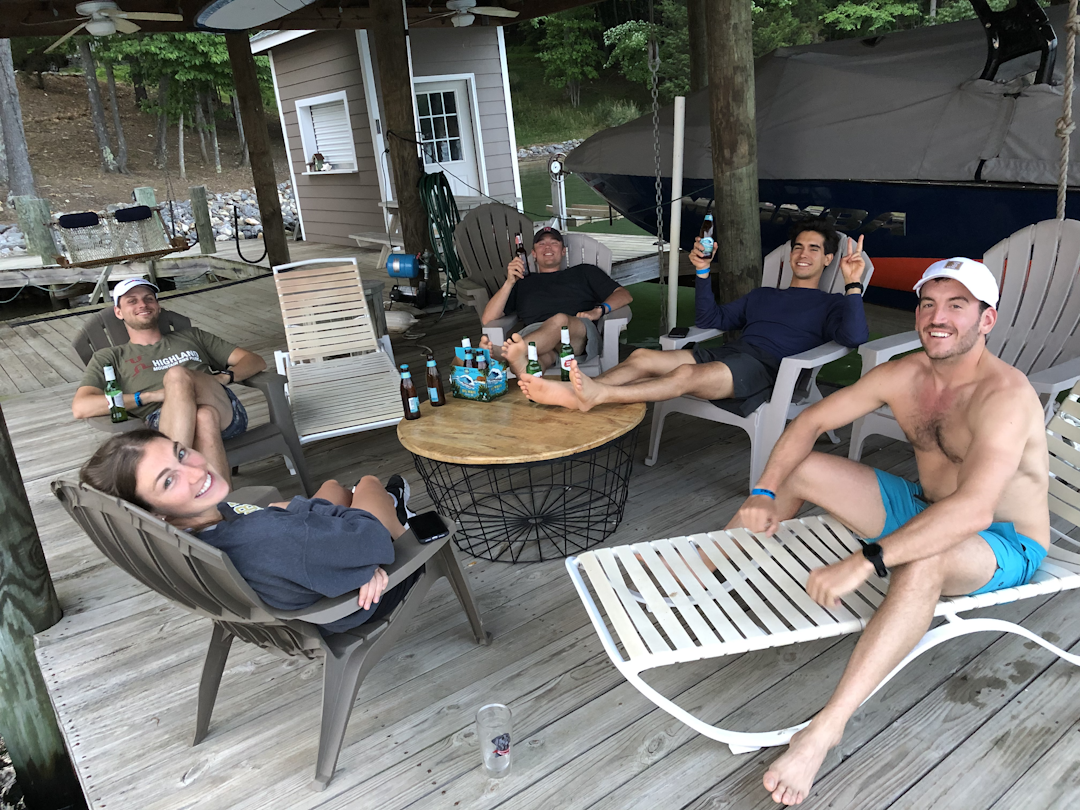
Johnny, Aj, Chris and I celebrating with Tori a few hours after the Iron Man near Roanoke, VA. The race took between 5 and 9 hours... depending on who you ask.
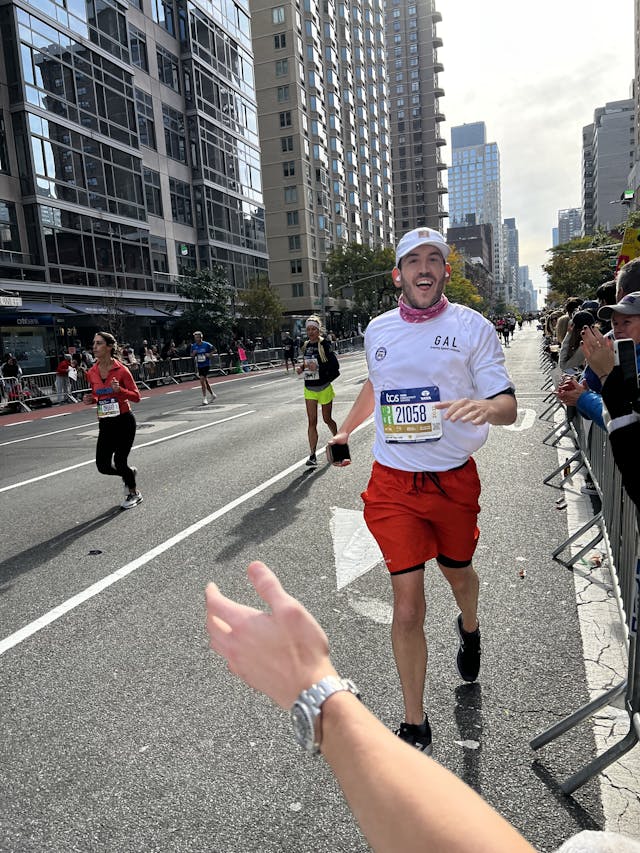
Running up 1st Ave roughly 16 miles into the NYC marathon!
Building At Google
Through living in Tahoe and eventually moving back to New York City, I was happily working for Google. In mid 2020, I’d joined an exciting new team that formed during the pandemic to help the surge of remote-learning students relying on Google Search. There hadn’t been any product focus on academic learning queries in the past, so our team built new search features to improve that experience (in contrast, tons of unique search features have been built for movies, music, and TV queries). In the fall of 2020, my team launched the math solver, a set of search features to recognize, solve, and present math problems directly on the search results page. On top of being a fun project to point to, it was a big success with students! So in 2021, I was tasked with growing the scope of our team from Search into YouTube.
My goal was to build features that improve the experience of students using YouTube as a learning tool. So I built a set features to help students find relevant learning content and focus while watching it. Removing distractions proved to be a difficult task—YT is optimized to increase user watch time, which at times directly opposed recommending high quality educational content. Despite that difficulty, I designed, built, and launched a set of these features, the first from our team within the YouTube product.
As an aside, in one of my experiments I crashed the YouTube "what to watch next" recommendation system. Apologies to the 0.5% of US-based users that found their recommended videos a bit odd for roughly 6 hours :).
The positives: I got to spearhead a new team within YouTube and launch features affecting millions of users, mostly students. According to our launch metrics, features I had developed increased Academic Learning Watch Time by tens of thousands of hours weekly! A drop in the bucket for the billions of hours watched on YouTube, but a step in the right direction.
The cons: bureaucracy took its toll. Search and YouTube are massively scrutinized entities, and making any changes takes time. There’s planning, designs, design approvals, building, testing, code reviews, experiments, experimental review, experiment launch, experiment analysis, and a series of other legal, product, and engineering reviews before any new change can permanently join the product in a certain language and geographic locale. It’s rightfully complex, but I found it difficult to be motivated after running into wall after wall. I couldn’t submit new code after 5:00pm PST. My time was increasingly spent navigating organizational complexity. I wanted to build, and it was still so early in my career that I knew I could grow faster than I was.
All of this was exasperated by the pandemic, where I found it difficult to form friendships remotely and get quick advice or feedback via chat and video. Had I been in the office with my teammates things may have turned out differently.
Committing to OnePager
At the start of 2021 OnePager was a very basic product that I was spending a few hours each night building and maintaining. We had no revenue streams but were beginning to experience solid user growth thanks to referrals from happy founders and partnerships with accelerators and incubators.
We came into the year with a straightforward plan: upgrade OnePager from a prototype to a built out SaaS product. Allow for users to create multiple OnePagers. Allow for multiple users to join an organization and together manage those OnePagers. Allow for multiple users to concurrently edit a OnePager. Add premium analytics, investor tools, additional fundraising data visualizations, and exports to use useful data off our platform. Revamp our marketing. Integrate with Stripe to print money. Do all of this while consistently attracting new founders, new investors, and keeping our current users happy.
So our developer at the time, Chris Yun, and I got to work. We ended up launching "OnePager 2.0" on April 1st, a deadline we forced on ourselves for an optimal Product Hunt launch. After a rocky 9:00pm-2:00am due to issues pushing the large backlog of changes to prod, the rest of the launch went great, and we got our biggest user bump yet. OnePager was now a fully built out product, not a prototype.
Throughout the rest of the spring/early summer we continued to refine the product and see steady user growth. Revenue also picked up as we attracted paid users to OnePager premium features for the first time. On top of that, we became increasingly involved with the AWS Startups team, who were happy to partner with us and get access to our breadth of early stage startups. Thus, the first promising model of OnePager presented itself.
We would attract companies to OnePager as a fundraising presentation tool, and based on their company data recommend them the perfect software for their business. OnePager was visibly a LinkTree/DocSend for startups, but the value was in the data. We’d monetize that data by helping founders build their companies with better tools and collect affiliate fees for promoting partner products. By early summer, we were sending so many companies to AWS that we formed a formal partnership. A few more partnerships like that would make us a serious business, and we were in the midst of both a startup boom and SaaS spending arms race (software discovery was an +80B market, and I assume is larger now).
With this model taking shape, I was completely torn. I was growing OnePager with my part time work and leadership, but I knew I had more to offer. The business had a fighting chance and it needed my full attention. I loved my work at Google, but I was bogged down in bureaucracy. Google was comfortable, and OnePager was the unknown.
I spent weeks deliberating but finally decided OnePager was undoubtably the better path forward. I owe it mostly to my good friend and co-founder Adam for ruthlessly recruiting me, and I’m also thankful for all the advice I got from friends, family, and mentors: my parents, Tori, Nic, Rich Napolitano, Alexander Fish, Bear Goldstien, Bear Altemus, Alistair Berven, George Gianos, Mac Cordrey, Dawit Heck, Chris Dale, Luke Armour, Anna Doherty, Brandon Arvanaghi, Ed Parizeau, Michael Greenberg, Suhail Doshi, Tom Cecil, Safwan Chowdrey, and Jon Novatnack to name a few.
This felt like an insane decision (people kill to work at Google!), so during the process I wrote our my reasoning in an essay to make sure I knew what I was getting into. I went through the pros and cons of both paths, my thoughts after various conversations, and my long term goals. The essay ended with this sentence:
“Doing this will be difficult and possibly fail, but it will move me closer to my ideal future as a proven builder and decision maker.”
And with that it was a no brainer, I was all in!
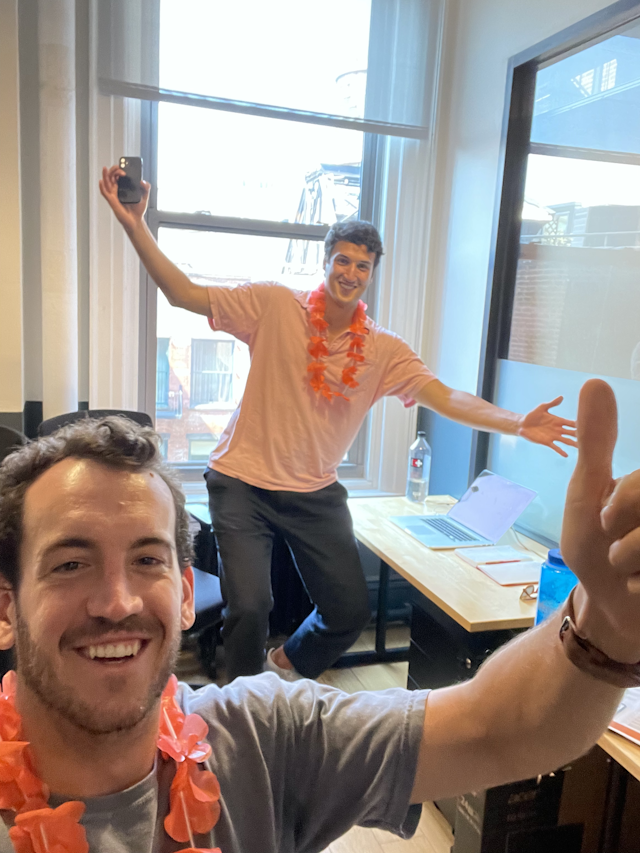
Adam and I in our OnePager WeWork office! (We were able to move in a day early and Nic couldn't make it, so this pic is really day -1)
Being a Founder
By mid summer I was a full time co-founder and CTO of OnePager, and the first ~8 weeks were a heads down blur. Nic and I had built out a backlog of critical bugs, styling changes, and long awaited features, so the "what to do" felt straightforward. Long hours building, testing, and launching. We continued to get great feedback from founders and user growth showed signs of acceleration. Things were generally looking up.
At this time we also began exploring product recommendations further. Up to this point, we’d focused on building out OnePager’s core presentation and sharing features, and we'd manually handled product recommendations via email. We were able to get the Amazon partnership by simply offering all users free AWS credits, but now we needed to recommend all sorts of software to various business types. So, I built out our V1 of automated product recommendations over the course of a week or so. From a technical perspective it worked well off the bat, but didn't garner the user engagement we’d hoped. We kept building and pushed forward.
Around this point I went to my first meetup with the NYC founders group thanks to a tweet from @FarzaTV. Since DMing him for an invite, I've gone every other Wednesday. It's been the perfect opportunity to talk about the newest OnePager features, set goals (+ keep them), and talk with other founders in the grind. I've met some truly ambitious and talented people: David (Covalent), Farza (buildspace), Lenny (Milk Video), Fed (GummySearch), Los (Tunestalgia) , and Houck (Launch House) to name a few. Right away the group was impressed by OnePager's initial traction, and some had even used us for fundraising! But, others suggested we needed to focus more on growth, and they turned out to be right.
In late September we had our first major course correction. Nic, Adam, and I attended a Product Hunt Event in SoHo and listened to guest speakers Shahed Kahn (founder of Loom) and Josh Buckley (CEO of Hyper). Afterwards, we managed to talk with Shahed and Josh for roughly an hour, and they gave us a rude awakening. We were a promising team with a solid product, but it meant nothing if we didn’t show strong growth. Josh said if we weren’t growing 10% week over week or saw a path to that kind of growth, our business wasn’t venture scalable. That was his benchmark. He liked us, but emphasized we needed to continue down the “idea maze”. He didn’t think OnePager in its current state would work.
From this point on, life at OnePager has felt much more startup-y. Happy users and a steady stream of companies is fine, but these aren’t necessarily metrics of success. We needed to optimize for users or revenue and show real growth. The app was in great shape, but it didn’t matter. We switched into full business experimentation mode. Build, launch, measure, decide next steps. (In hindsight, we may have overcorrected after this encounter, but I think it was a positive overall for us to stop working "heads down")
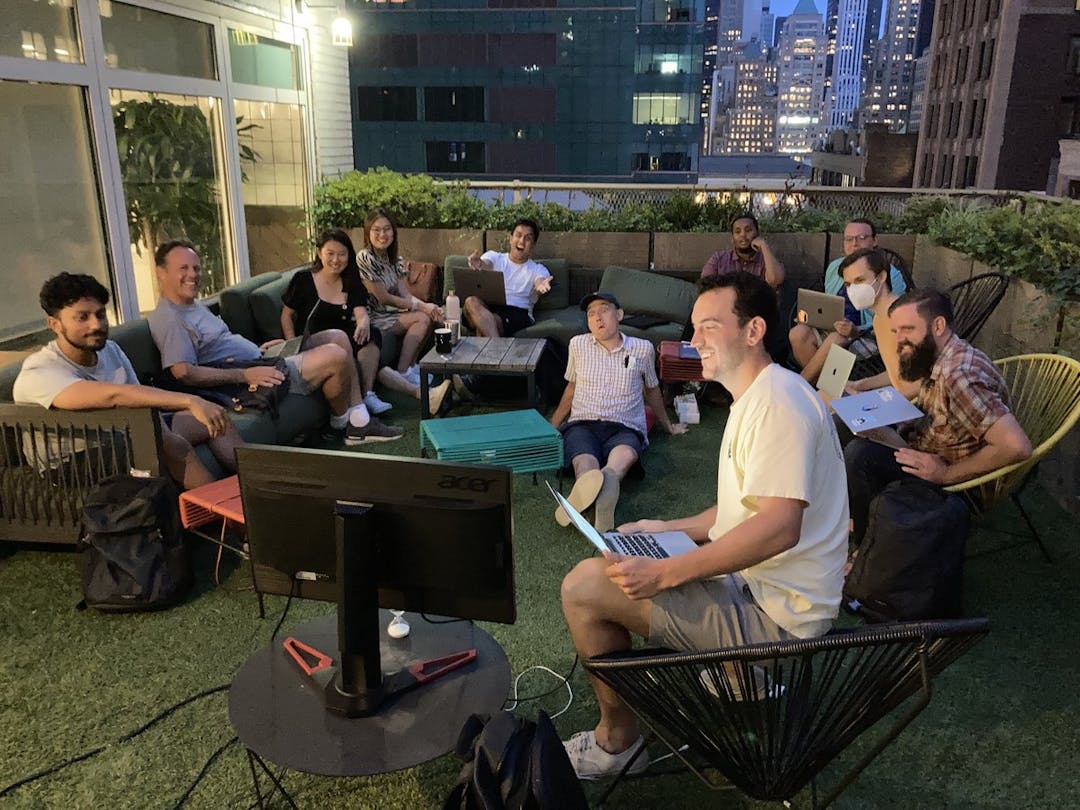
After my first NYC founders meetup, Farza tweeted this pic of me presenting OnePager for the first time to the group.
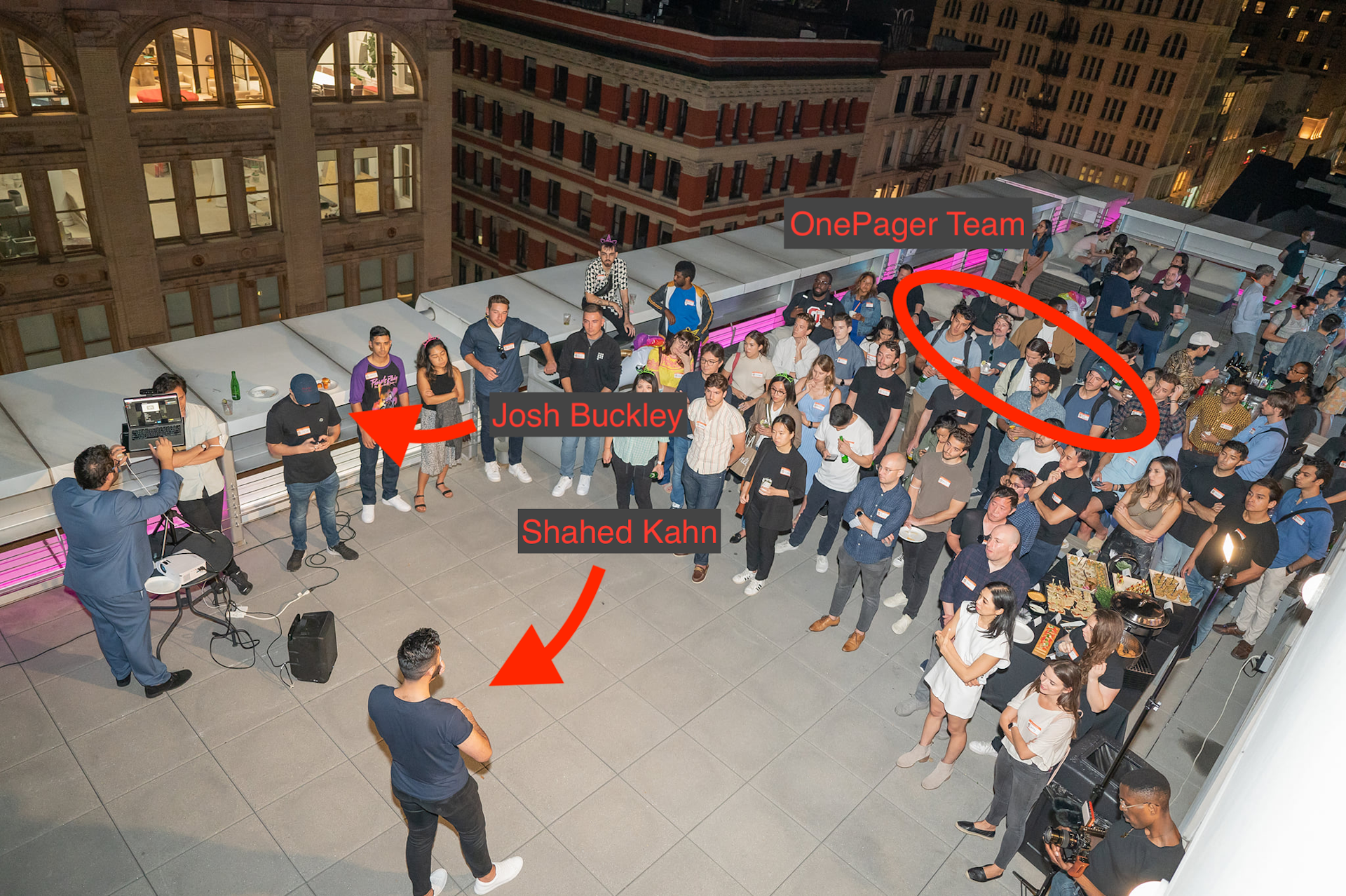
Adam, Nic, and I at a Product Hunt event in New York City. After this photo, we talked with Josh and Shahed about OnePager.
Going Down the Idea Maze
First we explored product recommendations further: as a stand alone tool, as an emphasized feature within OnePager, and in various delivery methods. With several weeks of experimenting and user interviews, product recommendations weren’t something users seemed particularly interested in. It had worked for AWS and was a great business model, but it didn’t get founders excited to join or invite their friends to drive growth. We left these features in the app as an added bonus and focused elsewhere.
Then we explored OnePager as a recruiting tool, an idea that came to us after we found user retention alarmingly low. Users would sign up for OnePager, fundraise, and suddenly leave. This is the nature of fundraising (you don’t do it forever), but it was a major problem. So, we optimized for recruiting. Fundraise with us, and then with your newly raised capital we can help you hire! I built a ton of recruiting features: new creation flows, data models, and visualizations. I created an automated newsletter of OnePager companies with open roles. I even created a referral bonus system baked into recruiting OnePagers. If you reviewed a role that seemed relevant to a friend, share it with them. If they get the job, you get the referral bonus! This feature set came built with tracking and a dashboard for users to review their active referrals.
This model showed signs of life, but was difficult to grow. Our Open Scout network embraced this side of OnePager with open arms and created hundreds of referrals generating thousands of job post interactions. Unfortunately though, we found this model extremely difficult to execute. We needed to keep three groups of users happy: companies hiring, people referring their friends, and job applicants. We also found recruiting to be a deeply fragmented and difficult industry to break into: you needed to show hundreds of people a job application to have only a few actually apply. Without real passion for this side of OnePager and having only committed a few weeks, we decided to move on. We left the recruiting features in OnePager, took a positive bump to our user retention, and focused our efforts back into the core fundraising product.
Fundraising is where we always got the best feedback. Founders loved the simplicity, visualization of data, and analytics of the tool. Investors loved getting our deal flow. We focused our efforts here.
This led us to our model today—we get as many companies as we can to sign up for OnePager, we show them off to investors, and we raise SPVs for the ones showing signs of success. This model is a win for both founders (they get a great tool and exposure) and investors (they get free deal flow). The SPVs also add a lot of value for many non-apex investors: they get access to hot deals and a simple way to directly invest. On a more granular level, the business model works like this:
- Businesses sign up on OnePager for fundraising exposure. (We make some revenue charging for premium analytics)
- We pick the best of these companies, ones that appear ready to raise and have opted in.
- We show those companies to our 1,000+ VC and Angel investor subscribers via newsletter.
- We track investor engagment, and find which companies have the highest interest from notable investors.
- We raise SPVs for those companies, earning revenue from setting up the deal and carried interest when the investment closes.
It’s unclear if this is the right path for our business, but we’re excited the way things have gone so far and where “the idea maze” is taking us. It’s of course been stressful, but it's also been an incredibly rewarding experience. I’ve owned our product end to end for nearly 2 years, spent 7 months as a full time founder, and led massive changes, real growth, and notable revenue. Overall, I do think we’ve made a small dent in venture capital, and more and more people are beginning to recognize the OnePager brand.
As we approach 2022, we're at a crossroads. We haven't put serious effort into raising money, mostly because we're not confident what business model we'd raise on. At the same time, we've built something that thousands have used and the majority have loved. We have a captive audience of investors, and a steady stream of great company signups. We know we've built something useful, and will decide in the coming weeks to stay the course or approach existing companies and ecosystems that could benefit most from our product and our expertise. This will be a big year for us.
I firmly believe that there should be more opportunities for people to start companies. Helping founders fundraise does just that, and I’m proud of what we’ve done so far!
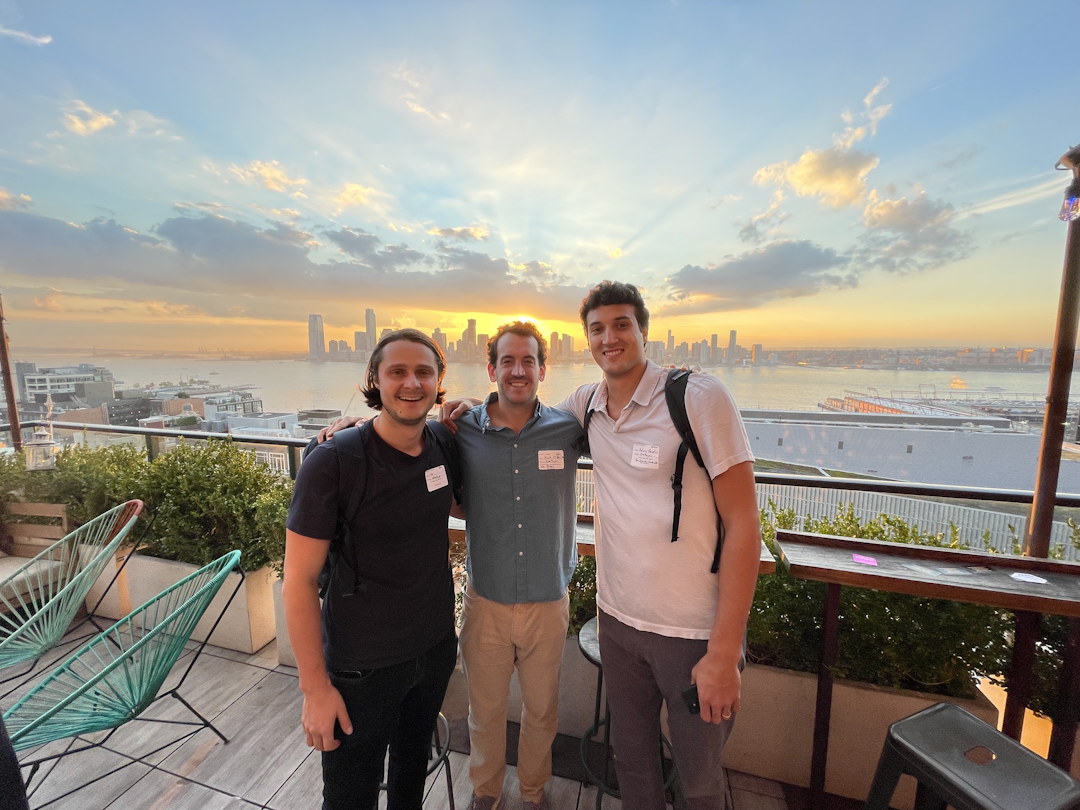
Nic, Adam, and I at a startup event in New York City hosted by Brex. The OnePager team never looked so good!
Conclusion
And that brings us to 2022! In the final days of 2021 I got COVID, so I’m optimistic about my health and new found immunity in the new year. If you've made it this far, I’m hoping for a healthy, happy new year for you too!
- Jack